While François Vivier’s Meaban is a pocket cruiser he designed some 16 years ago, it has the look of a classic from a more distant era. Its design is a development of the Stir-Ven, which is slightly smaller than the Meaban but has a larger cockpit, a small cuddy instead of a cabin, and a transom-mounted outboard instead of an inboard well. In the early 2000s, Vivier began discussions with Pierre-Yves de la Rivière of Grand-Largue, a boatyard in Brittany, about a new design, the Meaban, with a proper cabin, a self-draining cockpit, an outboard well within easy reach, and an option for an inboard engine.
“The Meaban’s look was in the spirit of some small yachts as drawn by François Sergent (the Loctudy) or Eugène Cornu (the Bélouga),” said Vivier. “As for all my designs, I wanted to draw a true classic, beautiful and suited to another way of sailing, away from modern marinas. For instance, the low draft makes it an excellent boat for visiting small, drying harbors.” Vivier was particularly keen that the centerboard case shouldn’t encroach too much into the cabin, and so he moved it aft so that it is partly in the cabin and partly in the cockpit. He moved the rig correspondingly aft and gave the hull a plumb stem to maintain balance.
He initially designed the boat for strip-planked construction—that was the preference of the person who ordered the first set of plans—but Vivier soon produced new plans for cold-molded construction “which is lighter, easier to build, and completely free of problems due to temperature or moisture content.” Around two dozen boats have now been built, mostly by amateurs, and most are cold-molded. François offers plans and patterns for both a strip-built version of the Meaban and the plywood version shown here. Offsets are not available, so the shapes of the plywood parts are provided as full-sized Mylar patterns or files for CNC-cutting. A 23-page manual is included as a builder’s guide.
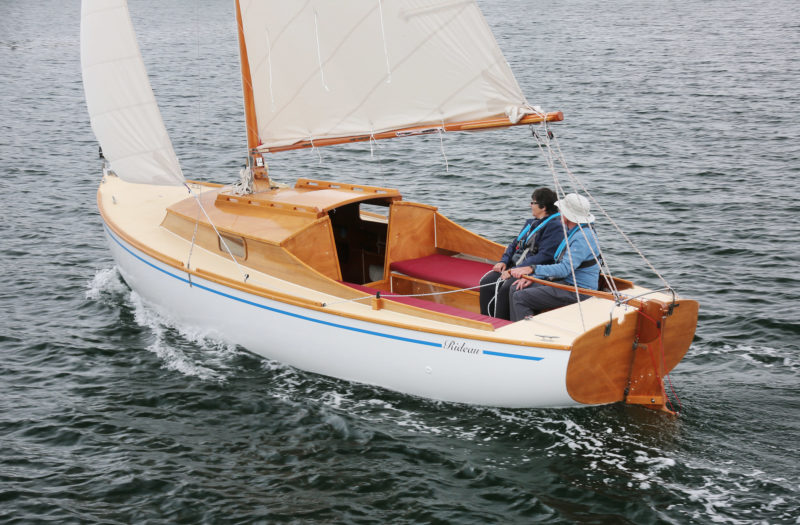 Photographs by the author
Photographs by the authorMeaban can be built cold-molded, strip-planked, or, as seen here, of marine plywood. Despite the modern construction, however, the design has a traditional flare.
The Meaban RIDEAU was built in Tasmania by Lindsay Pender for his own use. After taking delivery of the CNC-cut plywood components, Lindsay had to do a certain amount of finishing off. The notches for longitudinal components in the bulkheads, for instance, had rounded corners that he had to square off. For almost all the solid timber parts of the boat, Lindsay used celerytop pine, a species unique to Tasmania.
The boat is constructed around an egg-crate structure composed of plywood longitudinal components and 12 transverse bulkheads although some might be more accurately described as ring frames or semi-ring frames. Three of these—those in line with the forward and aft ends of the cabintop, and the one directly under the mast—are double thickness, as is the transom. After creating a building base, the bulkheads are set up vertically, upside down, along with the slightly angled inner transom layer. After the centerboard case is constructed, it is inserted into the appropriate cutouts in the bulkheads. The stem is laminated around a jig (the shape of which is provided by a Mylar template) and then set in position and notched into the forward-are bulkhead. For the hog, two lengths of 26mm x 140mm (1″ x 5-1⁄2″) timber are scarfed together and the slot is cut for the centerboard. This bends easily around the gentle rocker and is scarfed to the stem, then glued and screwed into the bulkhead and transom notches. The plywood parts of the longitudinal bulkheads, which run most of the length of the boat from the transom to the second-most forward bulkhead, are finger-jointed together and then fitted into their notches. Then the solid-timber beam shelf, stringers, and double stringers each side get put in place and trimmed flush with the aft face of the inner transom layer before the outer transom layer is fitted. The stem and hog are then faired in with the bulkhead edges to allow the hull planking to begin.
In the bottom part of the boat, the planking is made up of just one layer of 12mm (1⁄2″) plywood, which comes up to the middle of the double lower stringer. Lindsay had trouble bending and twisting the plywood in the forward part of the boat, and so he cut notches into the inner face and later filled them with epoxy. The remainder of the planking consists of three layers of 4mm plywood, laid in strips approximately 4″ wide with all of them aligned vertically and with the edge joints staggered in successive layers. There are about 300 such planks in total, and the edge of each of them has to be fitted to the edge of its neighbor. After the first two layers are butt-jointed to the 12mm bottom plywood along the double lower stringer, the third layer is fitted into a rabbet in the 12mm bottom plywood. The 12mm plywood and the first layer of 4mm plywood are epoxied to the hog, stem, and stringers and to the edges of the longitudinal and transverse bulkheads, with the next two layers of 4mm plywood epoxied to the preceding one and to each other. Staples and very small screws hold them in place while the epoxy set.
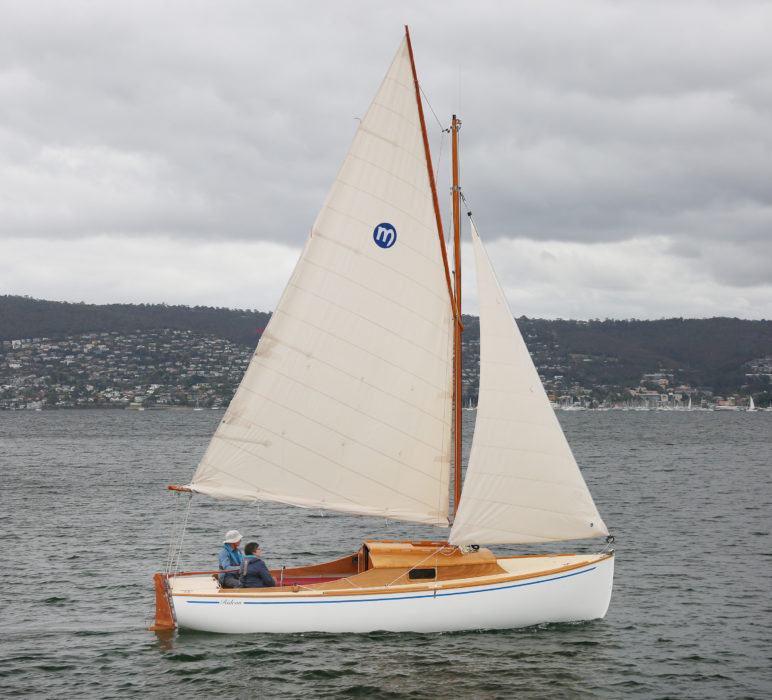
With its near-vertical ends and high-peaked gaff, François Vivier’s Meaban reflects the influences of traditional craft from France’s mid-Atlantic coast.
The wood keel that gets added next consists of seven 22mm (7⁄8″) laminates with a small solid section between the laminations and the hull at the aft end. The slot for the centerboard is cut into each of these seven pieces with a jigsaw prior to laminating. Within the wood keel there is a shaped recess for the 440-lb cast-lead ballast keel, which gets bolted in place. Lindsay made the pattern for this himself and had the foundry drill holes for the six 12mm keelbolts through the casting. Lindsay then fitted the lead keel while the hull was still upside down, using the holes in the lead to guide the drilling of the holes through the timber centerline components before bolting it on.
The outside of the hull gets faired and then sheathed with 200g (7 oz) biaxial cloth and epoxy, filled, faired, and painted. As recommended by Vivier, Lindsay did a great deal of the epoxy filleting between the structural components and the inside of the hull planking while the hull was upside down (although with hindsight he thinks it might have been easier to do it when it was the right way up).
After the hull is turned over, each of the individual internal hull panels forward of the mast bulkhead and those below the waterline elsewhere are sheathed with 200g biaxial cloth and epoxy.
The deck structure consists of 25mm x 25mm (1″ x 1″) carlins fitted into notches in the bulkheads and semi-ring frames, 30mm x 30mm (1 3⁄16″ x 1 3⁄16″) half deckbeams, 25mm x 60mm (1″ x 2 3⁄8″) deckbeams each side of the bulkhead directly below the mast, and various sizes of beams alongside bulkheads and ring frames in way of the foredeck. The cockpit and coach roof coamings are continuous, made up of two layers of plywood, each with staggered scarf joints. The cabintop is laminated from three layers of 4 mm plywood, and the side deck and foredeck are one layer of 10mm.
The cockpit sole sits on top of 20mm x 25mm (7⁄8″ x 1″) longitudinal members fixed to the inside faces of the longitudinal bulkheads, and the remainder of the cockpit and the outboard well are simply constructed from plywood and solid timber. The cabin’s interior joinery is similarly constructed and includes a berth each side and a double berth forward.
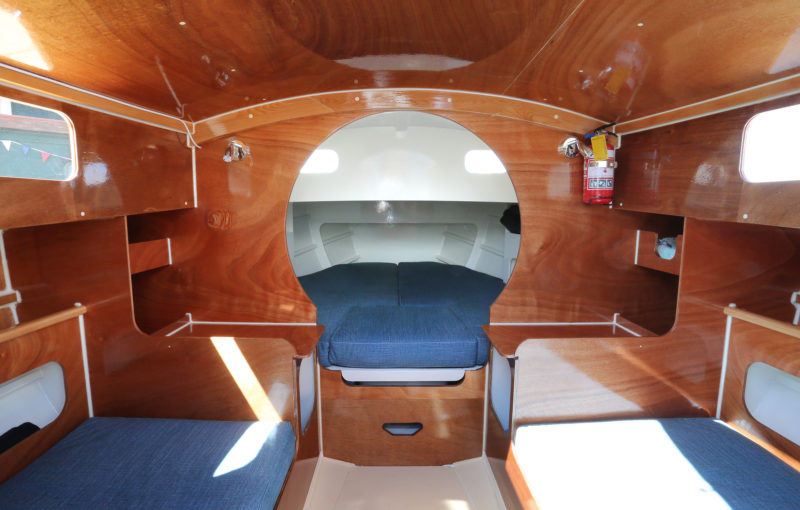
Down below, the cabin is welcoming. With ample natural light, the contrast of bright-finished solid celery pine and high-quality plywood in the main salon, offset by the white-painted forepeak, makes the interior appear simultaneously cozy and spacious. The side berths offer full sitting headroom, there is room for a stove, chart table, dining table and, beneath the V-berth, a portable toilet.
There is a space for a portable toilet centered under the aft end of the double berth. A chart table stows under the starboard cockpit seat and slides forward for use over the starboard seat/berth; and a dining table stows under the port cockpit seat and can be set up in the cabin by notching its forward end over the partial bulkheads at the ends of the seat/berths and supporting its aft end with a leg (although Lindsay finds it too wide to use comfortably). There is no stove installed, and Lindsay and his wife usually use a stand-alone propane stove in the cockpit. The interior is surprisingly spacious, and there is comfortable sitting headroom above the side seat/berths. Lindsay intends to make the seating more comfortable with the addition of backrest cushions.
Vivier designed Bermudan and gaff rigs for the Meaban, and Lindsay opted for the latter. The spars are of Oregon pine and of hollow construction, although the plans specify the boom should be solid. Lindsay fit a PVC pipe inside the mast to allow cables for a masthead light and a VHF aerial.
For shoreside stops, the plans include an anchor well, covered by a hatch in the foredeck, and beaching legs to keep the boat upright over its 6″-deep keel. Lindsey didn’t include these in RIDEAU.
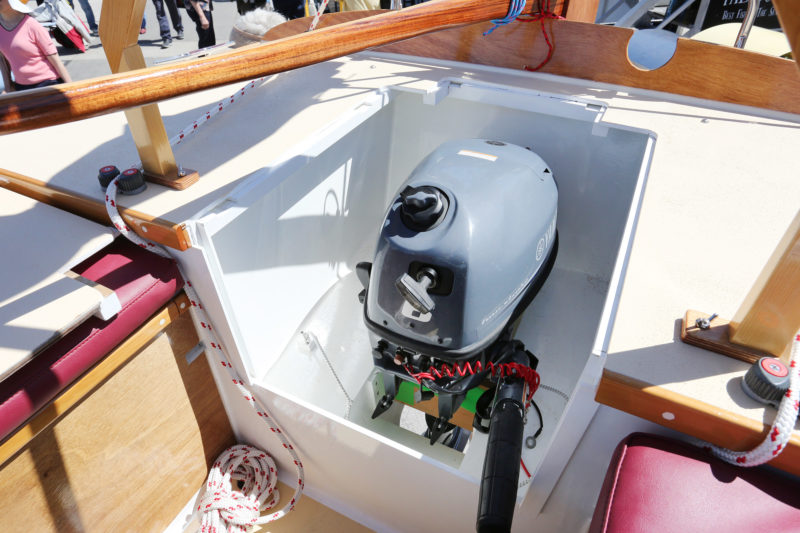
The outboard is housed in a well beneath the aft deck. When in use, it is enclosed for sound insulation, but two panels can be easily removed to provide convenient access for filling the gas tank, starting the engine, and putting it in gear. The throttle can be operated with the covers in place. Under power the boat is steered with the rudder. Note the sculling notch in the transom—a common feature on traditional French boats.
A mast tabernacle, made in stainless steel from a detailed drawing included with the plans, allows Lindsay to rig RIDEAU fairly easily by himself and, with an off-the-shelf trailer, launching and recovering is a relatively straightforward process. Under power, the 6-hp four-stroke Yamaha outboard gives the boat about 5.5 knots at wide-open throttle. The outboard itself cannot be turned in its well but, with the propeller immediately forward of the rudder, the boat is particularly maneuverable when going ahead. The plans detail an outboard well with two removable panels that cover the engine to reduce noise. The tiller extends through a notch in the forward panel to provide control of the throttle. The rudder has a kick-up blade, held down with a line secured to an auto-release clam cleat.
We sailed RIDEAU from Bellerive on the edge of Tasmania’s Derwent River and, while the photographs here might indicate that the conditions were benign, an unsettled forecast and some noticeably threatening gusts prompted us to put a reef in the mainsail. Nonetheless, even when the wind was relatively light, RIDEAU gave an enjoyable and lively sailing performance with a balanced helm. We tacked through an angle of about 110 degrees, although we agreed that this could be improved with a tighter jib luff. The cockpit was comfortably roomy for the three of us onboard. Taking the helm requires standing occasionally to look properly over the cabintop. The part of the centerboard case in the cockpit is barely noticeable, while its forward end inside the cabin is supports a step for easier access in and out of the cabin.
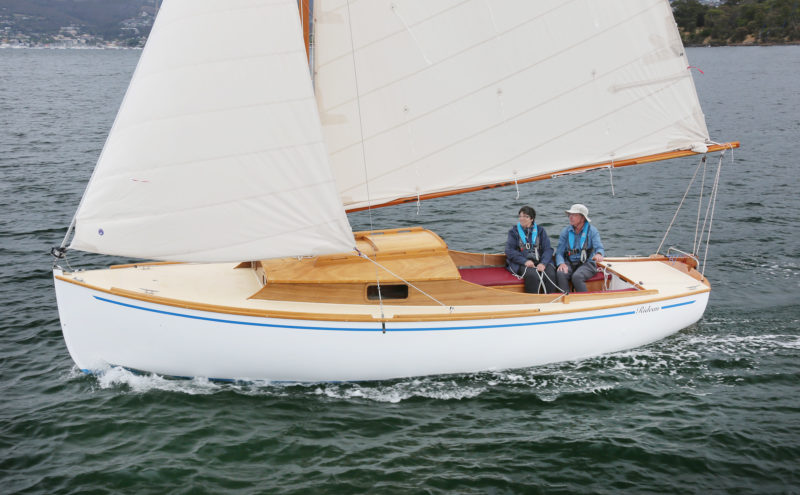
The double-ended mainsheet allows the helmsman to adjust the trim of the sail from either side of the spacious cockpit while the jibsheets are led well aft so that a singlehanded sailor could easily trim both sails.
Before we launched for our afternoon sail, Lindsay told me that the Meaban is “a dream to sail in light winds,” and I was soon able to see that for myself. Lindsay and his wife, who are not the most confident sailors, haven’t yet worked up to sailing in stronger winds but it was clear to me that, as they get used to the Meaban, not only would they have little to fear but they will have great fun with it.
In every way it seems that Vivier has achieved his aims for the Meaban: “To be a pleasant day and cruising boat, fast and easy to steer. To have the charm and beauty of a classic boat with a lovely cabin and a welcoming cockpit.”![]()
Nigel Sharp is a lifelong sailor and a freelance marine writer and photographer. He spent 35 years in managerial roles in the boat building and repair industry, and has logged thousands of miles in boats big and small, from dinghies to schooners.
Meaban Particulars
[table]
Length/22′4-1⁄2″
Waterline length/20′9-1⁄4″
Beam/7′6-3⁄4″
Depth/3′2-5⁄8″
Draft, board up/1′6-1⁄2″
Draft, board down/4′9-7⁄8″
Displacement (with motor and anchor)/2,591 lbs
Ballast (lead keel and centerboard)/ 695 lbs
Sail area/301 sq.ft.
[/table]
Study plans, plans, and patterns for the Meaban are available from François Vivier Naval Architect. Grand-Largue Boatyard, near Saint Malo, France, builds Meabans and offers kits.
Is there a boat you’d like to know more about? Have you built one that you think other Small Boats Magazine readers would enjoy? Please email us!
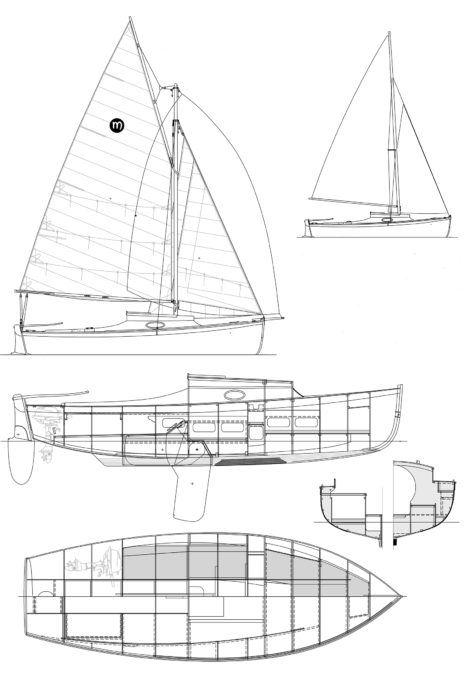
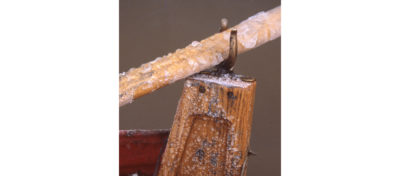



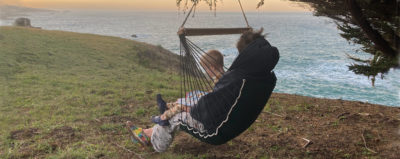

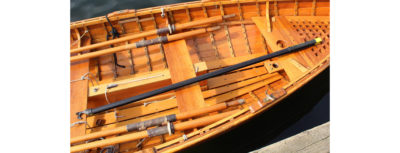

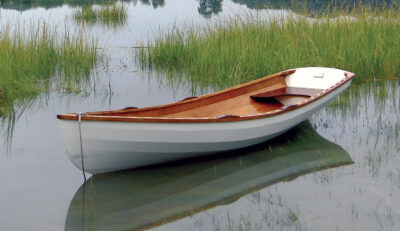
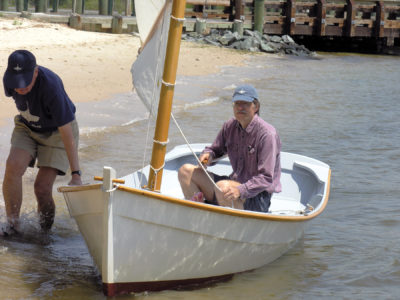
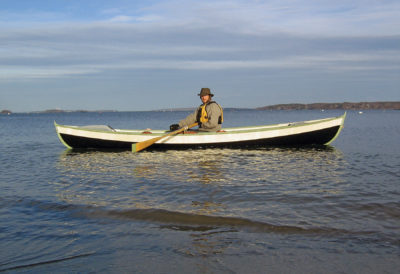
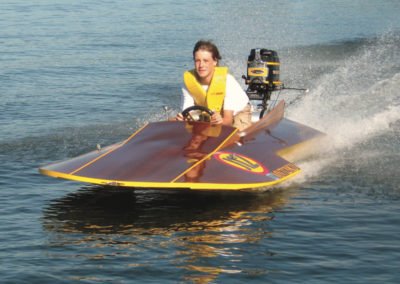
For this and future reviews of trailer boats I’d be interested to know how long does it take to rig the boat from road worthy to sailing shape. Also if the process can be done by a single person or requires some kind of team or mechanical advantage. Some trailer boats take so much labor they only see a trailer at the beginning and end of a sailing season while others are towed to various water bodies and sailed for a weekend or afternoon.
I would bet the gaff rigged version would be easier to set up than the Bermuda. Yes, you have the spar and it’s attendant rigging, but the mast is shorter and easier to handle.
As the builder/owner of RIDEAU I can say that rigging and unrigging at the boat launching ramp takes a little over an hour if I don’t get distracted. Raising the mast is simple and quick using a portable A-frame (2m high) arrangement which sits on the cabin slightly forward of tabernacle and held in place by ropes running forward and back to the berthing cleats. A rope running from the end of the mast, over a roller on top of the A-frame and then attached to the trailer winch raises the mast easily without too much force being placed on the tabernacle. Once the mast is raised the A-frame is stowed in the back of the towing vehicle. On one occasion I lowered and raised the mast at a marina using a double block and the same A-frame arrangement.
I have a Stirven with pretty much the same rig as the Meaban. Fastest I’ve rigged and been sailing is 30 minutes after pulling up to the boat ramp, this was with two of us working like a well-oiled machine. 45min is normal and easily managed by a solo sailor once you have a routine down pat.
I mostly rig and sail solo and don’t use A frames or winches to lift the mast, just stick it in the tabernacle and walk it up, takes about 30 seconds. Pack up always seems quicker than set up about 30 -35 minutes, not including washing boat and trailer after sailing. Hope that helps.
I’m a fan of many of Vivier’s designs. This one reminds me of a slightly compressed version of the San Francisco Bear Boats, designed and built by the Nunes brothers.
Great to see a local build such a beautiful sailboat in my home town of Hobart, Tasmania.
For readers in Australia, as I don’t have the skills to build my own, started searching several years ago and found the Cygnet 20.
Now the proud and happy owner of a Cygnet 20 sailing Victorian waters and soon to head south to my home State.
Any idea of the cost of the kit? Cost of mere plans and off cuts?
I’am just ending the building in France of my own Méaban and the total final cost is in the range of 30 000 Euros.Regarding the kit cost, you can find relevant information in the Pierre-Yves de la Rivière shipyard in France, regarding the plans all the data are on François Vivier website.You may ask him if he has partner in your country able to provide a kit.
I have a blog (in French) on my building.